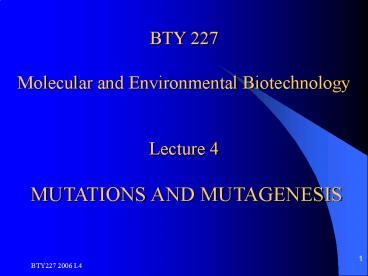Lecture 2 Mutations and Mutagenesis - PowerPoint PPT Presentation
1 / 22
Title:
Lecture 2 Mutations and Mutagenesis
Description:
Wild type strain is a strain of an organism ... Any organism may undergo a heritable change in the base sequence ... intercalation. BTY227 2006 L4. 17 ... – PowerPoint PPT presentation
Number of Views:133
Avg rating:3.0/5.0
Title: Lecture 2 Mutations and Mutagenesis
1
BTY 227 Molecular and Environmental
Biotechnology Lecture 4 MUTATIONS AND
MUTAGENESIS
2
Wild Types and Mutants
- Wild type strain is a strain of an organism
isolated from nature - Is the usual (native) form of the organism
- Any organism may undergo a heritable change in
the base sequence of its nucleic acid genome and
become a MUTANT
3
Some Definitions
- Mutant organism or strain whose genome carries
a mutation - Mutation inheritable change in the base
sequence of the genome of an
organism - Genotype the precise genetic makeup of an
organism - Phenotype the observable characteristics of an
organism Figure 1
4
Nomenclature hisC gene of E.coli
- This gene codes for a protein called the His C
protein enzyme involved in histidine
biosynthesis - Genotype of organism designated by 3 lowercase
letters followed by a capital letter (italics)
e.g. E. coli hisC - Mutations in hisC gene designated as hisC1, hisC2
- Phenotype of organism designated by capital
letter followed by 2 lowercase letters followed
by a or e.g. E.coli His - His strain of E.coli is capable of making
histidine, His- strain cant
5
Types of Mutants
6
Molecular Basis of Mutation
- Mutations can be spontaneous or induced
- Induced mutations result of exposure to physical
or chemical agents called mutagens - Spontaneous mutations occur as result of
- Errors in DNA replication
- DNA damage due to radiation/heat
- Action of transposons
7
Effect of a Mutation on a Cell
- The phenotypic change accompanying a mutation
depends on - Where in the gene the mutation occurred
- What the nucleotide change was
- What product the gene normally encodes
- Figure 2
8
Mutations may Result in Micro or Macrolesions
- May involve one (or a very few) base pairs
POINT MUTATIONS or MICROLESIONS - May involve many base pairs
- MACROLESIONS
9
Point Mutations/ Microlesions
- Figure 3
- These involve one or two bases
- Result in
- Transitions (pu for pu or py for py)
- Transversions (pu for py or vice versa)
- Frameshift mutations one base inserted this
changes the aa sequence of the protein
10
Back Mutations (Reversions)
- Point mutations are reversible Figure 4
- REVERTANT is a strain in which the WT phenotype
that was lost in the mutant is restored - Two types of revertants
- Same site revertant (true revertant)
- Second site revertant- due to presence of a
suppressor mutation (mutation that restores WT
phenotype without altering the original mutation)
(Pseudo revertant)
11
Macrolesions
- Figure 5
- Include
- Deletions
- Duplications
- Insertions
- Inversions
- translocations
12
Deletions
- Deletions can remove large regions of DNA
- Result in complete loss of function of gene
- Can span more than one gene
- These are NOT reversible by further mutations
13
Insertions
- Insertions can add many bases to a sequence
Figure 5 - result from errors during genetic recombination
- Inactivate the gene
- May be due to insertion of DNA sequences (700
1400 bp) called INSERTION SEQUENCES
14
Translocations and Inversions
- Translocations large DNA segment moves to new
location - Inversions orientation of DNA segment reverses
- Figure 5
15
Mutation Rates
- Spontaneous mutations occurs at a rate of 10-6
per generation - In a normal growing culture (108 cells per ml)
there are probably a number of different mutants
per ml of culture - Rate of transposition is higher 10-4
16
Mutagens
- Mutagens are chemical, physical or biological
agents that increase the mutation rate i.e.
induce mutations - Can classify mutagens according to mode of
action - Incorporation of base analogues
- Direct reaction with DNA
- intercalation
17
Base analogues
- Similar to normal bases and can be incorporated
into polypeptide chain during replication - They have different base pairing properties and
in subsequent replication events may form a
stable mutation
18
5 Bromouracilan Example of a Base Analogue
- Exists in keto state but often tautomerises to
its enol state - Keto state bonds with adenine
- Enol state pairs with guanine
- End up with AT to GC transition mutant
- Figure 6
19
Mutagens acting directly on DNA
- These mutagens change the structure of a base and
alter the base pairing characteristics - e.g. is methyl nitrosoguanidine (NTG), an
alkylating agent which adds methyl groups to
guanine, causing it to base pair wiyh thymine - Induce mutations at higher frequency than base
analogues because they are active even in
nonreplicating DNA - Figure 7
20
Intercalating Agents
- These mutagens insert themselves between adjacent
base pairs and push them apart - During subsequent replication this abnormal
structure leads to microinsertions/deletions and
frameshifts - E.g.s acridine orange, ethidium bromide
21
Nonionizing Radiation
- Purine and pyrimidine bases absorb UV radiation
strongly (abs max is 260nm) - Major effect of this radiation is the formation
of dimers between adjacent pyrimidines - During subsequent rounds of replication, DNA
polymerase hesitates at the dimers and can insert
incorrect nucleotides - Figure 8
22
Detection of mutants
- Replica plating is one technique
- Here we demonstrate how to detect nutritional
mutants organisms unable to synthesise leucine - Plate a premutagenised culture on complete medium
at concentration which will give rise to
indiviual colonies - Imprint these colonies on a replicating block
- Transfer colonies to fresh plates
- Complete medium
- Minimal medium containing all essential nutrients
except leucine - Colonies absent on minimal medium plate will be
leu auxotrophs































